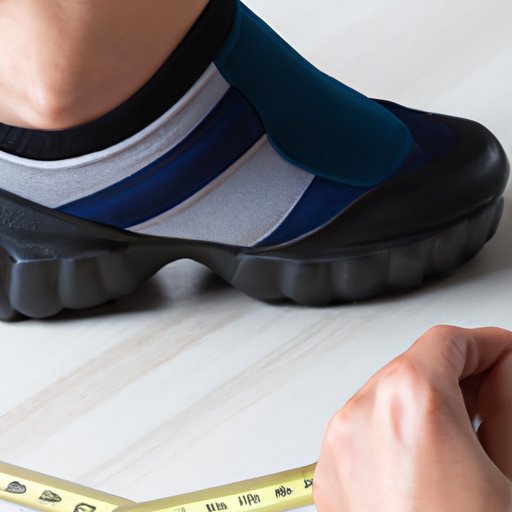
Introduction
Are you tired of buying shoes only to find they don’t fit quite right? Getting the right size shoe is essential for comfort and preventing foot problems. In this guide, we’ll explain how to measure your shoe size accurately, so you can ensure the perfect fit every time.
Step-by-Step Guide to Measuring Your Shoe Size at Home
To measure your foot, you’ll need a ruler, a piece of paper, and a pen. Follow these steps:
- Put the piece of paper on the ground against a wall or other hard surface.
- Place your foot on the paper with your heel snug against the wall.
- Mark the longest point of your foot with a pen or pencil, being careful not to angle the pen inward or outward.
- Use the ruler to measure the distance between the edge of the paper and the mark you made.
Once you have your measurement, you can use a shoe size chart to find your size in each brand. Keep in mind that sizes may vary slightly between brands, so it’s best to try shoes on before purchasing to make sure they fit well.
It’s also important to consider the shape of your foot and the style of the shoe you’re buying. Some shoes are designed for specific foot shapes, such as narrow or wide feet, and some may run larger or smaller than usual. Be sure to read reviews or ask a salesperson for advice when purchasing shoes that are new to you.
Why Accurate Shoe Measurements Matter and How to Get Them
Accurate shoe measurements are crucial for preventing foot pain and discomfort. Wearing shoes that are too small can cause blisters, corns, and other foot problems, while shoes that are too large can lead to slipping and sliding, which can be dangerous.
If you’re having trouble measuring your feet at home or want a more precise measurement, consider getting professionally fitted for shoes. A professional shoe fitter can take measurements from various angles, assess your foot shape, and recommend shoes that are best for your unique needs.
You can find professional shoe fitters at many shoe stores or podiatrists’ offices. Look for certified professionals who have experience fitting shoes for different foot types and conditions, and be prepared to spend extra time and money to get the perfect fit.
Common Mistakes When Measuring Your Shoe Size and How to Avoid Them
When measuring your feet at home, it’s easy to make mistakes that can throw off your measurements. Some of the most common mistakes include:
- Not standing up straight or putting weight on your foot
- Measuring while wearing thick socks or shoes
- Using a curved or angled pen to mark your foot
To avoid these mistakes, make sure you’re standing up straight and not leaning or shifting your weight. Measure while barefoot or wearing thin socks. Use a straight pen or pencil to mark your foot, and make sure the mark is parallel to the edge of the paper.
If you’re unsure whether you have the proper measurement, try measuring again or ask someone to help you. You can also try on shoes in-store to confirm your size before purchasing.
A Visual Guide to Measuring Your Shoe Size: Infographic Included
For a quick and easy guide to measuring your shoe size at home, check out our infographic below:

Remember to measure both feet, as they can be slightly different sizes. Use the larger of the two measurements when selecting your shoe size.
When to Update Your Shoe Size: Signs You Need a New Measurement
Feet can change size and shape over time due to factors such as weight gain, pregnancy, and aging. It’s important to regularly check your shoe size and update your shoe collection as needed.
Signs that it’s time to update your shoe size include:
- Feet are consistently sore or tired after wearing shoes
- Toenails are bruised or painful
- Blisters or calluses are forming frequently
- Toe or heel is sliding out of the shoe
To track changes in your foot size, consider measuring your feet every six to twelve months. You can also pay attention to how your shoes are fitting and adjust your collection accordingly. Donate or discard shoes that are no longer comfortable or supportive, and invest in new pairs that will keep your feet happy and healthy.
Conclusion
Measuring your shoe size accurately is an essential component of finding shoes that fit well and prevent foot pain and discomfort. Follow our guide to measuring your feet at home, and consider getting professionally fitted for shoes if you want an even more precise measurement.
Remember, finding the perfect pair of shoes may take some trial and error, but it’s worth the effort to protect your feet and keep them feeling great.





